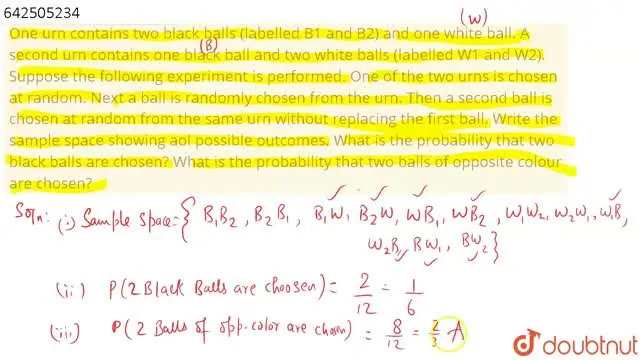One urn contains two black balls (labelled B1 and B2) and one white ball. A second urn contains one black ball and two white balls (labelled W1 and W2). Suppose the following experiment is performed. One of the two urns is chosen at random. Next a ball is randomly chosen from the urn. Then a second ball is chosen at random from the same urn without replacing the first ball. Write the sample space showing aol possible outcomes. What is the probability that two black balls are chosen? What is the probability that two balls of opposite colour are chosen?
It is given that one of the two urn is chosen, then a ball is randomly chosen from the urn, then a second ball is chosen at random from the same urn without replacing the first ball.
(i) ∴Sample space S={B1B2,B1W,B2B1,B2W,WB1,WB2,BW1,BW2,W1B,W1W2,W2B,W2,W1}
∴total sample point=12
(ii) If two black ball are chosen.
So, the favourable events are B1B2,B2B1,i.e.,2
∴Required probability=212=16
(iii) If two balls of opposite colour are chosen.
So the fourable events are B1W1,B2W1,WB1,WB2BW1,BW2,W1B1,W2Bi.e.,8.
∴Required probability=812=23
Related Playlists
- BOOK - NCERT EXEMPLAR ENGLISHCHAPTER - PROBABILITYEXERCISE - Objective Type Questions12videos
PROBABILITY
- BOOK - NCERT EXEMPLAR ENGLISHCHAPTER - PROBABILITYEXERCISE - True/False7videos
PROBABILITY
- BOOK - NCERT EXEMPLAR ENGLISHCHAPTER - PROBABILITYEXERCISE - Matching The Columns2videos
PROBABILITY
- BOOK - NCERT EXEMPLAR ENGLISHCHAPTER - PRINCIPLE OF MATHEMATICAL INDUCTION EXERCISE - OBJECTIVE TYPE QUESTIONS5videos
PRINCIPLE OF MATHEMATICAL INDUCTION
- BOOK - NCERT EXEMPLAR ENGLISHCHAPTER - RELATIONS AND FUNCTIONS EXERCISE - True /False5videos
RELATIONS AND FUNCTIONS
Similar Questions
An urn contains 4 balls. Two balls are drawn at random from the urn (without replacement) and are found to be white. What is the probability that all the four balls in the urn are white ?
View SolutionAn urn contains 4 balls. Two balls are drawn at random from the urn (without replacement) and are found to be white. What is the probability that all the four balls in the urn are white ?
View SolutionTwo balls drawn from an urn containing 2 white, 3 red and 4 black balls. What is the probability that the ball is red?
View SolutionTwo balls are drawn from an urn containing 2 white, 3 red and 4 black balls one by one without replacement. What is the probability that at least one ball is red?
View SolutionTwo balls are drawn from an urn containing 2 white , 3 red and 4 black balls , one by one without replacement . What is the probability that
at least one ball is red ?View SolutionAn urn contains 3 white, 4 red and 5 black balls. Two balls are drawn one by one without replacement. What is the probability that at least one ball is black?
View SolutionAn urn contains 9 red 7 white and 4 black balls. A ball is drawn at random. The probability that ball drawn is neither black nor red is
View SolutionAn urn contains 4 white and 3 red balls. Three balls are drawn at random from the urn with replacement. Find the probability distribution of the number of red balls.
View SolutionTwo balls are drawn from an urn containing 2 white , 3 red and 4 black balls , one by one without replacement . What is the probability that
both balls are of the same colour ,View SolutionTwo balls are drawn from an urn containing 3 white, 5 red and 2 black balls, one by one without replacement. What is the probability that at least one ball is red ?
View Solution


